When Ho Hsien-jung (何顯榮) and Lin Sheng-yi's (林勝義) startling publication, Taiwan -- The Cradle of Civilization (台灣 -- 人類文明原鄉), hit bookstores last year neither of them expected it to become a best-seller. They did, however, expect the book to be taken more seriously in academic and governmental circles than it was.
"I expected to get some kind of feedback after I sent copies of the book to various governmental departments and university academics," explained Ho, president and chief investigator of the Taiwan Unidentified Flying Objects Association (TUFOA,
The book puts forward the notion that the first seeds of human civilization in Asia were planted on a landmass known as Mudalu (姆大陸), which once stretched from Taiwan to Hawaii.
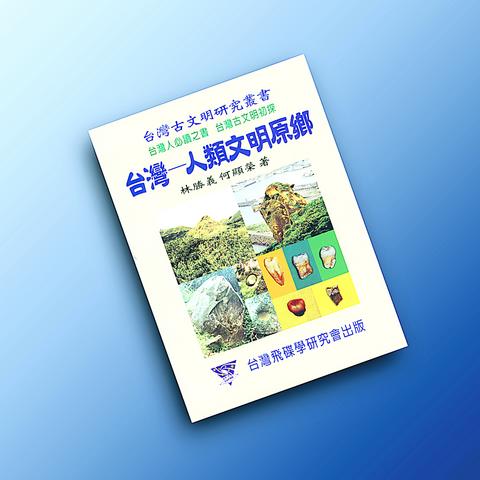
PHOTO COURTESY OF TUFOA
By using known geographical and historical dates along with some educated -- or as some believe uneducated -- guesses, Lin and Ho concluded that humankind did not spread to the rest of Asia out of China or islands in the Pacific.
As executive director of the Ketagalan of Taiwan Indigenous Culture Alliance (KTIS, 台灣凱達格蘭文化工作) Lin has spent over a decade researching and cataloging Taiwan's Stone Age past. "It's pretty obvious when you look at the facts. The spread of humanity throughout Asia and the Pacific began on a landmass of which Taiwan was a part," Lin said. "The ancient Ketagalan were an advanced people. From evidence we've uncovered we're sure they were the first people to implement some form of writing, albeit in pictorial form."
While dismissed by local academics, Taiwan -- The Cradle of Civilization did grab the attention of British journalist and author, Graham Hancock, writer of the international bestsellers The Sign and The Seal and Fingerprints of the Gods. The unconventional thinker and eyebrow-raising questioner of humanity's prehistory was so impressed by Lin and Ho's work that he flew to Taiwan in order to meet with both men and learn more about Taiwan's past.
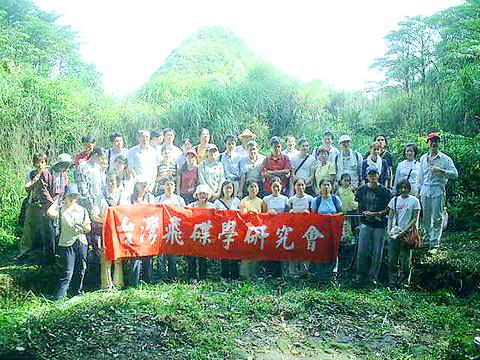
PHOTO COURTESY OF LIN SHENG-YI
"Hancock was very impressed with what he saw in Taiwan in regards to the probability of the existence of an ancient people with the intelligence to record what they saw on rock faces as well create edifices that were formed with such mathematical precision," Ho explained.
Although not boasting anything on par with internationally recognizable megaliths such as Stonehenge or the giant rock faces on Easter Island, there are according to James Huang (黃朝明), president of the Taiwan Ufology Society (TUS, 台灣飛碟學會), plenty of less grandiose yet equally important ancient stone structures scattered throughout Taiwan.
Extensive research by Lin has to date unearthed over 30 ancient megaliths from Keelung to Pingtung with many more believed to be in existence throughout the nation's less populated mountainous areas where the Ketagalan once lived. It's the ancient structures located in the Taipei area, however, that Lin believes are the key to increasing people's awareness of their long-forgotten past. While proving a slow process, and one that sees members of TUFOA, TUS and KTIS considered little but crackpots in some circles, the idea that Taiwan was once the center of the known world is finding an increasing number of advocates.
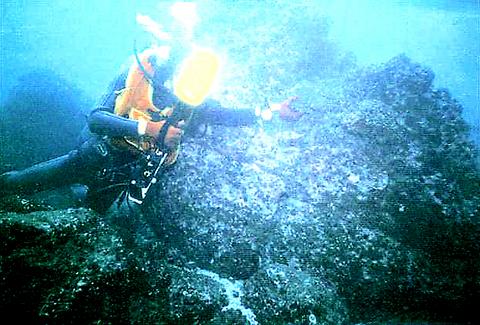
PHOTO COURTESY OF LIN SHENG-YINLEFT, KETAGALAN CARVINGS THOUGHT
Yangmingshan pyramid
When the nation's first pyramid and megalith meeting took place last June only 60 people turned out. Twice that number attended the group's second meeting last Sunday and hiked through the undergrowth of some of the more out-of-the-way parts of Taipei's Yangmingshan National Park (
Located roughly 100m from the summit of Chihsing Mountain, the most important, yet least-known of these is a 20m-tall pyramid which is covered in grass and looks like a small hill. The pyramid's subterranean underbelly reportedly houses a series of interconnecting caves which some believe connect it with several other of Yangmingshan's suspected Stone Age sites.
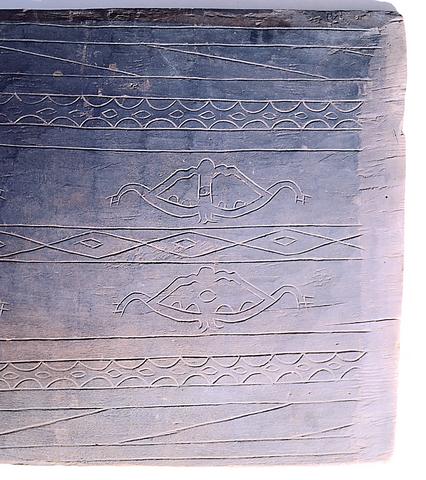
The pyramid first raised eyebrows in official circles after Japanese authorities on Taiwan founded the Tatun National Park (大屯國立公園) -- now Yangmingshan National Park -- in 1935. But the park became the property of the Ministry of Defense in the late 1940s and public access was prohibited. The pyramid was all but forgotten until the mid-1980s when Yangmingshan National Park re-opened to the public and it began to generate interest among amateur historians.
Academic teams from the nation's institutes of higher learning, however, steered clear and have continued to do so, much to the chagrin of Lin, Ho and the increasing number of those who share their ideas.
With the exception of a minor investigation in the 1980s when soil from the pyramid's outer layer was examined and dated to roughly 6000BC, the strange edifice remains virtually untouched by professional archeologists with up-to-date equipment.
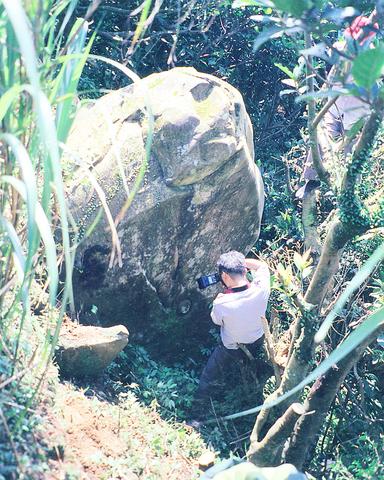
PHOTO COURTESY OF TUFOA
"Obviously you can't simply go there and start digging around. It's on national park land after all. The fact that no government body or educational institute has even attempted an in-depth survey makes it look as if nobody wants to know the history of the pyramid, though," Ho explained, "I mean, what are they scared of finding?"
The task of researching such ancient ruins, according to Ho, belongs to the archeology department of the National Taiwan University. When contacted by the Taipei Times, a spokesperson for the department denied reports it was investigating the ruins. According to Lin such a denial is understandable, as people are afraid of finding a truth that would support the pair's findings and rewrite history books. In Lin's opinion, all of this adds up to something that the powers-that-be are unwilling to face up to.
"Instead of bothering to investigate it, the official line has been that the pyramid was created by volcanic activity, which is impossible as the structure is virtually an exact triangle," Lin said. "And nature could never have created such an exact shape."

PHOTO: GAVIN PHIPPS, TAIPEI TIMES
The lack of an in-depth survey means that theories as to the origins of the pyramid are legion. These include everything from the pyramid being the burial chamber of a prominent Ketagalan official, to a place where the ancients worshipped, or even a message to alien beings.
One person who has managed to collect data on the mysterious structures on Yangmingshan is Leu Lii-chang (呂理昌). A 19-year veteran of the Taiwan's National Parks' administrative team, Leu has spent much of the last decade photographing and studying Yangmingshan's Stone Age past.
"Much of the information I have gathered over the years clearly points to the mountain's importance during the Stone Age. Many of the artifacts we've discovered can be dated at between 6000 to 3000BC," Leu explained. "But obviously more extensive research is not going to happen unless serious excavation work at the sites is undertaken. A radar scan of the area would be nice, but such a venture would prove very expensive."
Unexplained phenomena
Although one of the few people to undertake such lengthy research, Leu has managed to steer clear of the controversy that has plagued Lin and Ho. Leu readily admits that although he suspects the pyramid was a Ketagalan burial site, the lack of conclusive evidence means that he has kept an open mind.
"There's really no way to tell, which of course only adds to the mystery," admitted Leu. "Is it a natural hillock caused by volcanic activity? Or was it built by early man? Or, and as quite a few people believe, was it in fact built by or for aliens?"
Stranger still is the ancient megalith that sits in an equally out-of-the-way part of Yangmingshan National Park, a rock formation that is 3m in height by 1m in diameter. Historians, archeologists and even ufologists have long been divided as to when and by whom this rock formation was erected. Although there is scant evidence as to the site's original use, historians such as Lin think that the site was an altar where the Ketagalan worshipped their long-forgotten gods.
"As you can see the rocks have been shaped and put together so as to represent two gigantic beasts meeting head on," Lin explained. "We haven't found human bones in the area, however, which is why we can safely presume that it was built by the Ketagalan peoples who I believe didn't hold human sacrifices. If it predated them to the Nandao peoples (南島民族) say, then there would certainly be fossilized human remains of some kind in the area."
This isn't the only theory on the origins of the rock formation. Others think it is a clear message to beings on distant planets.
"When ancient peoples sat down to create art they drew what they saw in front of them. There was no need for imagination. If they saw an animal they drew it and so on," Lin said. "Looking at these carvings in wood, which have been officially dated to the Ketagalan period, it's obvious that UFOs were spotted and their presence was recorded by Stone Age peoples."
Other such Ketagalan carvings reportedly depict radio waves and strange individuals wearing outlandish and somewhat alien-looking headgear.
While the Yangmingshan megaliths continue to attract most of the attention, 100m down in the murky waters off the coast of Penghu's Hujingchen Island (澎湖-虎井沈) lays the most puzzling of all of Taiwan's ancient structures.
First discovered in 1982 by a Japanese research team, the underwater structure resembles a gigantic cross and measures over 100m in length and 1m in depth. Since its initial discovery, however, local divers have ceased to research the underwater edifice. As with the nation's land-based megaliths and mysterious carved rocks, Ho and Lin believe the reasons behind the choice to ignore it are based on a refusal to go against the grain.
"Putting it simply they're scared. They're scared to admit that maybe the history books are all wrong. And they're equally scared to bring into question our hows and whys," argued Ho. "After all, proving that we didn't in fact originate from China, but instead from Taiwan would irk a lot of people, especially Beijing. And I'm sure they are scared to this."

Taiwan is one of the world’s greatest per-capita consumers of seafood. Whereas the average human is thought to eat around 20kg of seafood per year, each Taiwanese gets through 27kg to 35kg of ocean delicacies annually, depending on which source you find most credible. Given the ubiquity of dishes like oyster omelet (蚵仔煎) and milkfish soup (虱目魚湯), the higher estimate may well be correct. By global standards, let alone local consumption patterns, I’m not much of a seafood fan. It’s not just a matter of taste, although that’s part of it. What I’ve read about the environmental impact of the

It is jarring how differently Taiwan’s politics is portrayed in the international press compared to the local Chinese-language press. Viewed from abroad, Taiwan is seen as a geopolitical hotspot, or “The Most Dangerous Place on Earth,” as the Economist once blazoned across their cover. Meanwhile, tasked with facing down those existential threats, Taiwan’s leaders are dying their hair pink. These include former president Tsai Ing-wen (蔡英文), Vice President Hsiao Bi-khim (蕭美琴) and Kaohsiung Mayor Chen Chi-mai (陳其邁), among others. They are demonstrating what big fans they are of South Korean K-pop sensations Blackpink ahead of their concerts this weekend in Kaohsiung.

The captain of the giant Royal Navy battleship called his officers together to give them a first morsel of one of World War II’s most closely guarded secrets: Prepare yourselves, he said, for “an extremely important task.” “Speculations abound,” one of the officers wrote in his diary that day — June 2, 1944. “Some say a second front, some say we are to escort the Soviets, or doing something else around Iceland. No one is allowed ashore.” The secret was D-Day — the June 6, 1944, invasion of Nazi-occupied France with the world’s largest-ever sea, land and air armada. It punctured Adolf

The first Monopoly set I ever owned was the one everyone had — the classic edition with Mr Monopoly on the box. I bought it as a souvenir on holiday in my 30s. Twenty-five years later, I’ve got thousands of boxes stacked away in a warehouse, four Guinness World Records and have made several TV appearances. When Guinness visited my warehouse last year, they spent a whole day counting my collection. By the end, they confirmed I had 4,379 different sets. That was the fourth time I’d broken the record. There are many variants of Monopoly, and countries and businesses are constantly